|
National Archaeological Museum of Athens - Prehistoric Collection
The New York Times has recently (April 2008) published an article on Athens. In it there is a reference to the National Archaeological Museum of Athens: "In neighboring Exarcheia, the renovated National Archaeological Museum (Patission 44; 30-210-821-7724) has classical sculptures and gold treasures from Mycenae". We think of this reference as being the Understatement of the century! |
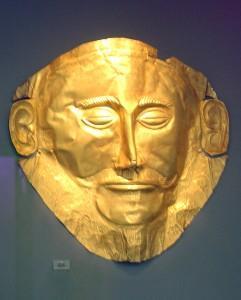 |
Athens National Archaeological Museum:
Exhibit 624. Gold death-mask, known as
the 'mask of Agamemnon'. (Grave V,
Grave Circle A, Mycenae, 16th century BC) |
This is because the Greek National Archaeological Museum in Athens is rightfully considered to be not only the most important, yet also one of the richest archaeological museums in the world in terms of containing Ancient Greek Art! Please refer to the relevant Album as proof of how much right we are!
The Greek National Archaeological Museum is housed in a neoclassical building designed by the noted German architect Ernst Ziller in 1889. It houses perhaps the most impressive collection of ancient Greek treasures in the world. The neoclassical design of the exterior tries its best to keep up with the true Greek classic style of the works it houses. This museum includes the golden so-called "Mask of Agamemnon", excavated by Heinrich Schliemann at ancient Mycenae, the bronze "boy jockey" of Artemision that somehow stayed in great condition despite being fished out of the sea, and a range of excellent sculptures, pottery, furniture and jewellery.
Further wonderful inclusions are:
- Prehistoric items/Ruins
- Sculpture
- Pottery and Minor art
- Bronzes
- Egyptian Art
Operating Hours are as follows:
Monday 13.00-19.30
Tuesday-Sunday 08.30-15.00
Telephone Contact: 210/821-7717 Address: 44, 28th Oktovriou (Patission) Ave, Athens, Greece |
Note: Given the huge number of exhibits, this album on the National Archaeological Museum of Athens is progressing step by step: Please visit this Album from time to time to see it growing!
(Photos: Michael Tziotis)
Select Page of the Album:
- The National Archaeological Museum of Athens: Why this Album?
- The National Archaeological Museum of Athens (The Building)
- Prehistoric Collection / Gallery IV / Mycenaean Civilization / Mycenae
- Gallery IV / Mycenaean Civilization / Mycenae / Grave Circle A / Finds from Graves I, II and VI, 16th century BC
- Gallery IV / Mycenaean Civilization / Mycenae / Grave Circle A / Finds from Grave III, 16th century BC (Window 1)
- Gallery IV / Mycenaean Civilization / Mycenae / Grave Circle A / Finds from Grave III, 16th century BC (Window 2)
- Gallery IV / Mycenaean Civilization / Mycenae / Grave Circle A / Finds from Grave IV, 16th century BC.
- Gallery IV / Mycenaean Civilization / Mycenae / Grave Circle A / Finds from Grave V, 16th century BC.
- Gallery IV / Mycenaean Civilization / Mycenae / Grave Circle A / Jewelry from Graves IV and V, 16th century BC.
- Gallery IV / Mycenaean Civilization / Mycenae / Grave Circle A / Gold and silver tableware from Graves IV and V, 16th century BC.
- Gallery IV / Mycenaean Civilization / Mycenae / Grave Circle A / Pottery vessels, 16th- early 15th century BC.
- Gallery IV / Mycenaean Civilization / Mycenae / Grave Circle A / Ritual vases-rhytons from Graves IV and V, 16th century BC.
- Gallery IV / Mycenaean Civilization / Mycenae / Grave Circle A / Exotic Objects, 16th century BC.
- Gallery IV / Mycenaean Civilization / Mycenae / Grave Circle A / Bronze vessels and tools from Graves III, IV and V, 16th century BC.
- Gallery IV / Mycenaean Civilization / Mycenae / Grave Circle A / Weapons and implements from Grave IV, 16th century BC.
- Gallery IV / Mycenaean Civilization / Mycenae / Grave Circle A / Weapons and implements from Grave V, 16th century BC.
- Gallery IV / Mycenaean Civilization / Mycenae / Grave Circle B / Finds from Graves Alpha, Zeta, Eta and Kappa, 17th-16th cent. BC
- Gallery IV / Mycenaean Civilization / Mycenae / Grave Circle B / Finds from the Male Inhumations in Grave Nu & the Female One in Grave Omicron, 17th-16th cent. BC
- Gallery IV / Mycenaean Civilization / Mycenae / Grave Circle B / Finds from Grave Gamma and Delta, 17th-16th cent. BC
- Gallery IV / Mycenaean Civilization / Mycenae / Grave Circle B / Finds from Graves Beta, Epsilon, Iota, Lamda, Mu, Xi, Upsilon, 16th century BC.
- Gallery IV / Mycenaean Civilization / Mycenae / Bone, Glass and Ivory Artifacts from the Mycenean Acropolis
- Gallery IV / Mycenaean Civilization / Mycenae / Palatial Workshops Finds and Bronze Weapon and Tool Hoards in the Acropolis of Mycenae, 14th-13th centuries BC
- Gallery IV / Mycenaean Civilization / Mycenae / Imported objects and raw materials from abroad, most found on the Mycenae acropolis.
- Gallery IV / Mycenaean Civilization / Mycenae / Clay and stone ritual vessels, used in religious ceremonies (15th-12th century BC).
- Gallery IV / Mycenaean Civilization / Mycenae / Pictorial Style pottery from the Mycenae acropolis.
- Gallery IV / Mycenaean Civilization / Mycenae / Wall-Paintings
- Gallery IV / Mycenaean Civilization / Tiryns/The Tiryns wall-paintings
- Gallery IV / Mycenaean Civilization / Tiryns/The Acropolis of Tiryns
Click on any of the pictures to enlarge.
Gallery IV / Mycenaean Civilization / Mycenae / Wall-PaintingsThe art of wall-painting first appeared in Minoan Crete and was closely associated with palatial architecture. Indeed, monumental painting was an official art, undertaken by artists who worked for the king. The iconography is inspired from the natural world or exhibits religious ceremonies from the royal court. The art of wall-painting spread to mainland Greece with the construction of the palaces at Mycenae, Tiryns, Thebes and Pylos, after the Mycenaeans established themselves at the palace of Knossos in Crete, at the end of the 15th century BC. The Mycenaean artist used natural earth colors, made mainly of metal oxides, which he applied onto a wet plaster surface.
The 13th century BC wall-paintings from the rooms of the Cult Center at the south-west section of the Mycenaean citadel, near Grave Circle A, are especially important. They include a scene of religious offering to a goddess and the representation of figure-of-eight shields, which may symbolize a military deity.
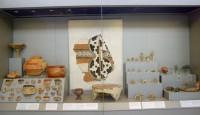
General View of the Window housing Mycenaean Clay and Stone ritual vessels (to the right), Pictorial Style pottery (left) and one of the two relatively large figure-of-eight shield wall-paintings. |
|
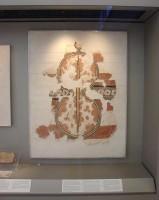
National Archaeological Museum: The Window with the second figure-of-eight shield wall-painting |
|
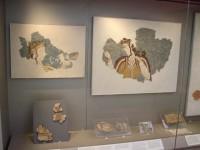
National Archaeological Museum: The Window with the rest of the Mycenaean wall-paintings
The second figure-of-eight shield wall-painting in the previous photo is barely visible at the bottom right side of this photo. |
|
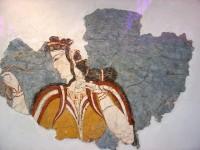
11670. The so-called Mycenaean Lady wall-painting
She wears a short-sleeved bodice over a sheer blouse, which delineates her ample bosom. Her intricate hairstyle and rich jewelry (necklaces and bracelets) are striking. |
|
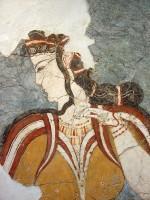
11670. The so-called Mycenaean Lady (Closer look)
She wears a short-sleeved bodice over a sheer blouse, which delineates her ample bosom. Her intricate hairstyle and rich jewelry (necklaces and bracelets) are striking. |
|
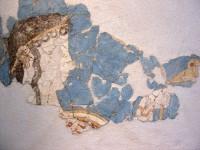
11651. Fragment of a wall-painting depicting a female figure participating in a procession, which bears offerings to the goddess.
Her elegant head is shown in profile, while her body is depicted frontally. She holds a lily in her left hand, a gift to the goddess. |
|
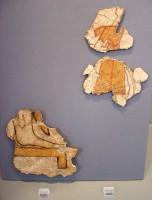
11635, 11636. Two fragments of a wall-painting depicting a seated goddess.
Her foot rests on a footstool and she holds a votive female figurine. A unique representation, which illustrates the use of the many female figurines found in Mycenaean shrines. |
|
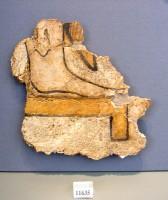
11635. One of the two fragments in the previous photo: Her foot resting on a footstool. |
|
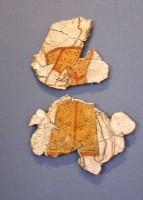
11636. The second one of the two fragments in the previous photo: The votive female figurine. |
|
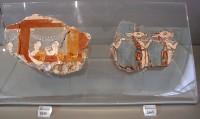
1015, 2665. Fragment of a wall-painting depicting three women looking out of the windows of a festooned house (1015) and another one depicting daemons in what appears to be a hunting scene (2665).
Details in the following two photos... |
|
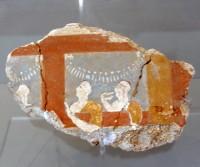
1015. Fragment of a wall-painting depicting three women looking out of the windows of a festooned house.
The scene's festive character and women's gestures of veneration and surprise indicate that they are watching a religious spectacle. From the Ramp House, Mycenae Acropolis. 14th century BC. |
|
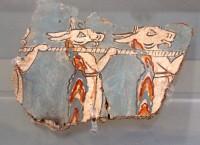
2665. Fragment of a wall-painting depicting daemons in what appears to be a hunting scene.
Three lion-headed daemons, though conventionally called ‘ass heads’, walk to the right holding a pole from which their prey hangs. This type of daemon originated in Egypt and is connected with vegetation rituals. |
|
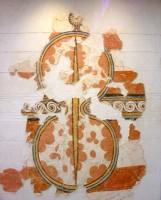
11672, 11671. Wall-paintings depicting figure-of-eight shields with a suspension strap at the middle.
The motif on each shield's surface shows that they represent originals made of cow's hide. The figure-of-eight shield, a defensive weapon, becomes here the symbol of a war goddess. Although it is a common motif (models of this type of shield exist in gold, ivory and semi-precious stones), this is a rare representation in Mycenaean monumental painting. |
|
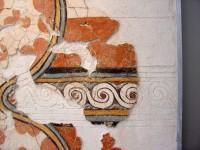
11672, 11671. Wall-paintings depicting figure-of-eight shields with a suspension strap at the middle. (Detail)
The motif on each shield's surface shows that they represent originals made of cow's hide. The figure-of-eight shield, a defensive weapon, becomes here the symbol of a war goddess. Although it is a common motif (models of this type of shield exist in gold, ivory and semi-precious stones), this is a rare representation in Mycenaean monumental painting. |
|
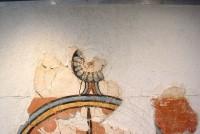
11672, 11671. Wall-paintings depicting figure-of-eight shields with a suspension strap at the middle. (Greater Detail)
The motif on each shield's surface shows that they represent originals made of cow's hide. The figure-of-eight shield, a defensive weapon, becomes here the symbol of a war goddess. Although it is a common motif (models of this type of shield exist in gold, ivory and semi-precious stones), this is a rare representation in Mycenaean monumental painting. |
|
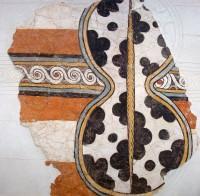
11672, 11671. Wall-paintings depicting figure-of-eight shields with a suspension strap at the middle.
The motif on each shield's surface shows that they represent originals made of cow's hide. The figure-of-eight shield, a defensive weapon, becomes here the symbol of a war goddess. Although it is a common motif (models of this type of shield exist in gold, ivory and semi-precious stones), this is a rare representation in Mycenaean monumental painting. |
|
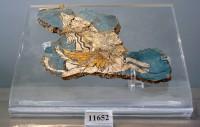
11652. Fragment of a wall-painting depicting a female figure, possibly a deity, wearing a helmet and holding a galloping griffin.
Homer describes the boar's tusk helmet, which was an essential component of a Mycenaean warrior's attire. The griffin (a mythical creature with the head and wings of an eagle and a lion's body), a common motif in Creto-Mycenaean iconography and a symbol of power, is depicted on the walls of the throne rooms of the palaces at Knossos and Pylos. |
|
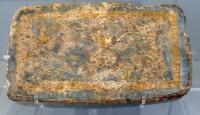
2666. Plaster tablet with a cult scene (the so-called Palladium)
A female figure holding a figure-of-eight shield, probably a war deity, stands between two votary priestesses. A small double concave altar underlines the religious character of this scene. The female deity has been connected to classical Greek Pallas Athena. |
|
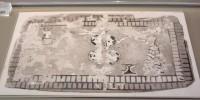
2666. Drawingn-copy of the plaster tablet with a cult scene (the so-called Palladium)
A female figure holding a figure-of-eight shield, probably a war deity, stands between two votary priestesses. A small double concave altar underlines the religious character of this scene. The female deity has been connected to classical Greek Pallas Athena. |
|
|
Select Page of the Album:
- The National Archaeological Museum of Athens: Why this Album?
- The National Archaeological Museum of Athens (The Building)
- Prehistoric Collection / Gallery IV / Mycenaean Civilization / Mycenae
- Gallery IV / Mycenaean Civilization / Mycenae / Grave Circle A / Finds from Graves I, II and VI, 16th century BC
- Gallery IV / Mycenaean Civilization / Mycenae / Grave Circle A / Finds from Grave III, 16th century BC (Window 1)
- Gallery IV / Mycenaean Civilization / Mycenae / Grave Circle A / Finds from Grave III, 16th century BC (Window 2)
- Gallery IV / Mycenaean Civilization / Mycenae / Grave Circle A / Finds from Grave IV, 16th century BC.
- Gallery IV / Mycenaean Civilization / Mycenae / Grave Circle A / Finds from Grave V, 16th century BC.
- Gallery IV / Mycenaean Civilization / Mycenae / Grave Circle A / Jewelry from Graves IV and V, 16th century BC.
- Gallery IV / Mycenaean Civilization / Mycenae / Grave Circle A / Gold and silver tableware from Graves IV and V, 16th century BC.
- Gallery IV / Mycenaean Civilization / Mycenae / Grave Circle A / Pottery vessels, 16th- early 15th century BC.
- Gallery IV / Mycenaean Civilization / Mycenae / Grave Circle A / Ritual vases-rhytons from Graves IV and V, 16th century BC.
- Gallery IV / Mycenaean Civilization / Mycenae / Grave Circle A / Exotic Objects, 16th century BC.
- Gallery IV / Mycenaean Civilization / Mycenae / Grave Circle A / Bronze vessels and tools from Graves III, IV and V, 16th century BC.
- Gallery IV / Mycenaean Civilization / Mycenae / Grave Circle A / Weapons and implements from Grave IV, 16th century BC.
- Gallery IV / Mycenaean Civilization / Mycenae / Grave Circle A / Weapons and implements from Grave V, 16th century BC.
- Gallery IV / Mycenaean Civilization / Mycenae / Grave Circle B / Finds from Graves Alpha, Zeta, Eta and Kappa, 17th-16th cent. BC
- Gallery IV / Mycenaean Civilization / Mycenae / Grave Circle B / Finds from the Male Inhumations in Grave Nu & the Female One in Grave Omicron, 17th-16th cent. BC
- Gallery IV / Mycenaean Civilization / Mycenae / Grave Circle B / Finds from Grave Gamma and Delta, 17th-16th cent. BC
- Gallery IV / Mycenaean Civilization / Mycenae / Grave Circle B / Finds from Graves Beta, Epsilon, Iota, Lamda, Mu, Xi, Upsilon, 16th century BC.
- Gallery IV / Mycenaean Civilization / Mycenae / Bone, Glass and Ivory Artifacts from the Mycenean Acropolis
- Gallery IV / Mycenaean Civilization / Mycenae / Palatial Workshops Finds and Bronze Weapon and Tool Hoards in the Acropolis of Mycenae, 14th-13th centuries BC
- Gallery IV / Mycenaean Civilization / Mycenae / Imported objects and raw materials from abroad, most found on the Mycenae acropolis.
- Gallery IV / Mycenaean Civilization / Mycenae / Clay and stone ritual vessels, used in religious ceremonies (15th-12th century BC).
- Gallery IV / Mycenaean Civilization / Mycenae / Pictorial Style pottery from the Mycenae acropolis.
- Gallery IV / Mycenaean Civilization / Mycenae / Wall-Paintings
- Gallery IV / Mycenaean Civilization / Tiryns/The Tiryns wall-paintings
- Gallery IV / Mycenaean Civilization / Tiryns/The Acropolis of Tiryns
|
|
|
|



